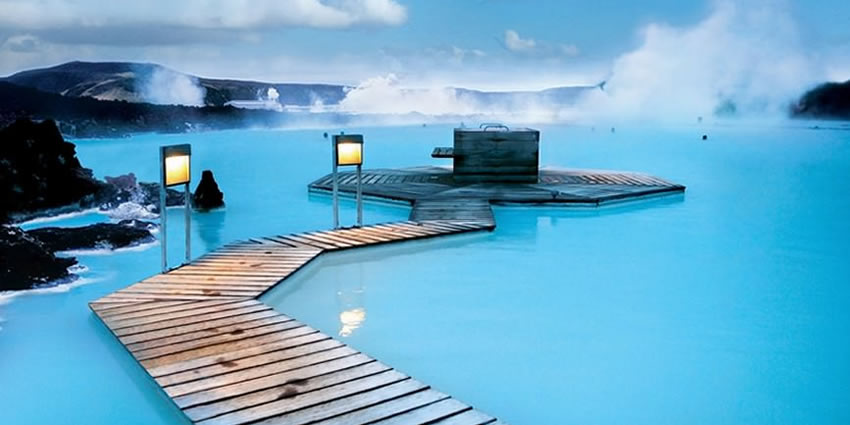Blue Lagoon

The Blue Lagoon geothermal spa is one of the most visited attractions in Iceland. The spa is located in a lava field in Grindavík on the Reykjanes Peninsula, southwestern Iceland. Bláa lónið is situated approximately 20 km from the Keflavík International Airport and 39 km from the capital city of Reykjavík, roughly a 20-minute drive from the airport and a 50-minute drive from Reykjavík.
The warm waters are rich in minerals like silica and sulfur and bathing in the Blue Lagoon is reputed to help some people suffering from skin diseases such as psoriasis. The water temperature in the bathing and swimming area of the lagoon averages 37–39°C. The Blue Lagoon also operates a research and development facility to help find cures for other skin ailments using mineral-rich water.
The lagoon is a man-made lagoon that is fed by the water output of the nearby geothermal power plant Svartsengi and is renewed every two days. Superheated water is vented from the ground near a lava flow and used to run turbines that generate electricity.
After going through the turbines, the steam and hot water pass through a heat exchanger to provide heat for a municipal water heating system. Then the water is fed into the lagoon for recreational and medicinal users to bathe in.
Iceland has a strict code of hygiene and guests are required to shower before bathing.
Children under the age of 9 years old are only allowed entry with the use of armbands, provided free of charge. The lagoon is not suitable for children under the age of 2 years.
The rich mineral content is provided by the underground geological layers and pushed up to the surface by the hot water (at about 1.2 MPa (170 psi) pressure and 240°C temperature) used by the plant. Because of its mineral concentration, water cannot be recycled and must be disposed of in the nearby landscape, a permeable lava field that varies in thickness from 50 cm to 1 m.
The silicate minerals are the primary cause of that water’s milky blue shade. After the minerals have formed a deposit, the water reinfiltrates the ground, but the deposit renders it impermeable over time, hence the necessity for the plant to continuously dig new ponds in the nearby lava field.
A small experimental facility is still visible near the plant, where the engineers made decantation tests to evaluate the speed of mineral deposition, which is clearly a limiting factor both to the plant’s rentability and sustainability. Hence, geothermal energy exploitation at this location is not without environmental impact.
The Blue Lagoon was used as the pit stop for the first leg of The Amazing Race 6. The Blue Lagoon was used for the thermal spa scenes in the filming of Hostel: Part II. It was also shown in the Incubus documentary Look Alive, when the band visited Iceland, in the fifth cycle of Britain’s Next Top Model which was used as a photoshoot location as well as Keeping up with the Kardashians.
The Blue Lagoon is situated close to the world’s first renewable methanol plant, which uses Carbon Recycling International’s carbon dioxide to methanol fuel process.
In 1976 a pool formed at the site from the wastewater of the geothermal power plant that had just been built there. In 1981 people started bathing in it after its purported healing powers were popularized. In 1992 the Blue Lagoon company was established and the bathing facility was opened for the public.